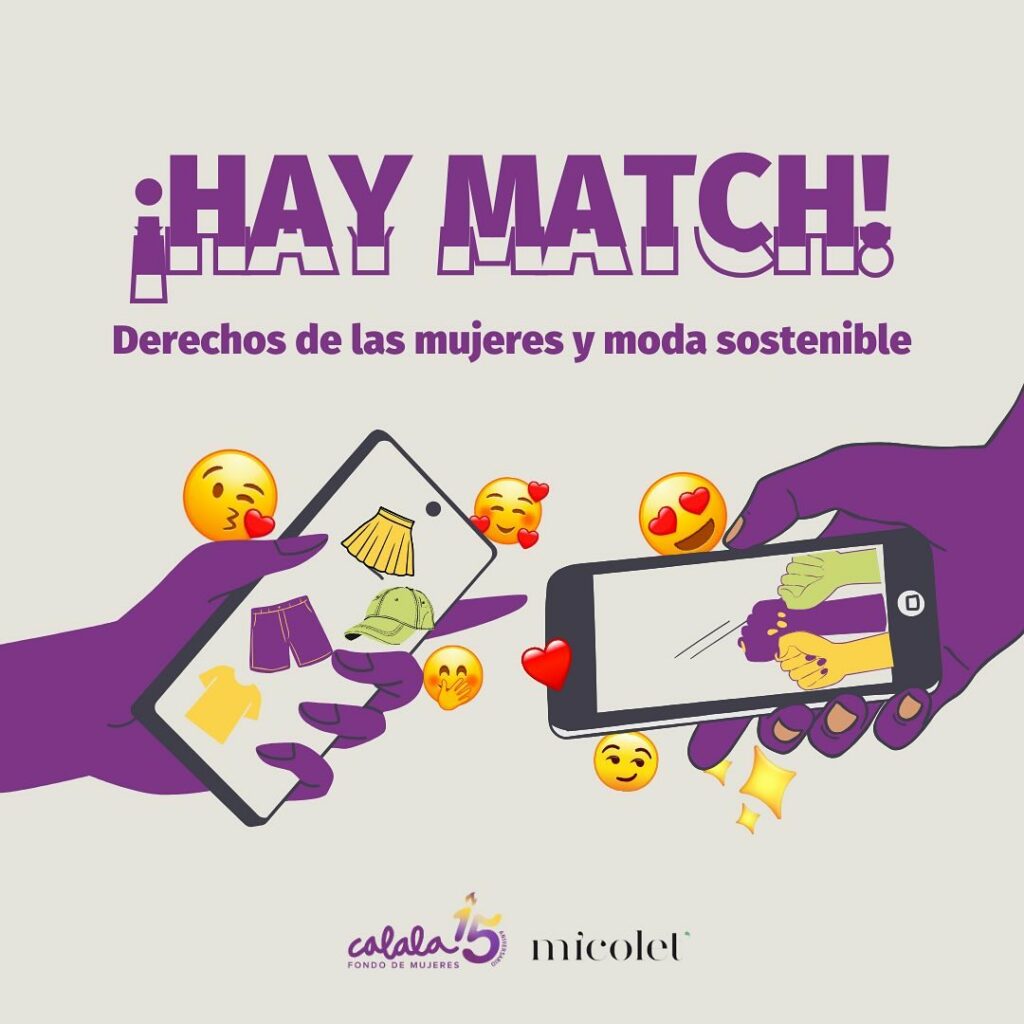Vega-C lanzará la misión Smile de la ESA para estudiar el clima espacial

La ESA se asegura, el lanzamiento de su misión Smile a bordo de un cohete Vega-C, tras la firma de un acuerdo con Arianespace

Vende ropa de segunda mano para recaudar fondos
Por Mar Andrades, consultora en Ágora Social.
Para las organizaciones que no pueden mantener una tienda física de ropa de segunda mano, una opción cada vez más popular es recurrir a la venta online en sitios especializados. Micolet es una de esas plataformas que ofrece una solución sencilla para las ONG que tienen pocos recursos.
Micolet: una plataforma para recaudar fondos con la venta y recogida de ropa
Esta web de venta de ropa de segunda mano, con sede en el Pais Vasco, opera en varios países, incluyendo España, Reino Unido, Francia, Alemania, e Italia. Con más de un millón de usuarios, ofrece una amplia audiencia para las organizaciones que desean abrir esta vía de recaudación de fondos.
Para las ONG, Micolet ofrece dos opciones para recaudar fondos:
- Armario solidario: permite a las entidades tener un armario personalizado lleno de ropa donada por los usuarios exclusivamente para esa entidad. De las prendas que se vendan de este armario, la entidad recibe casi el 100% del precio de la prenda, menos un pequeño porcentaje destinado a gastos de gestión de la plataforma.
- Donación por prenda aceptada: en esta opción, la ONG recibe 1€ por cada prenda donada que haya sido aceptada para su venta. Aunque esta opción no incluye un armario personalizado para la entidad, si se hacen llamamientos a la recogida de ropa de forma masiva, puede resultar beneficioso.
La empresa realiza el pago de las prendas vendidas durante la primera semana de cada mes. Deben pasar como mínimo 8 semanas desde el día de la venta y tener un saldo acumulado a favor de la ONG superior a 4€. Estos plazos son necesarios para gestionar adecuadamente las devoluciones, si las hubiera.
El caso de Calala
Un ejemplo del empleo de esta estrategia es el caso de la organización Calala Fondo de Mujeres, una ONG que trabaja para promover los derechos de las mujeres y niñas. Calala recibe regularmente donaciones de ropa de segunda mano de sus seguidores y las vende a través de Micolet. Esta empresa se encarga de la recogida y la validación de las prendas para colgarlas posteriormente en el armario personalizado de la entidad.
Es fundamental que la estrategia de venta de ropa de segunda mano esté alineada con el discurso y los valores de tu organización. En este sentido, promover la compra de ropa de segunda mano como un acto solidario que apoya la misión de la organización, puede ser clave. En el caso de Calala, su responsable de marketing digital y donantes individuales, Rocío Marcos, nos comenta que en las comunicaciones enfatizan que con cada compra de ropa de segunda mano no solo se beneficia al comprador, sino que también apoya el avance de los derechos de las mujeres. De esta manera, se hace partícipe al donante en la misión de la organización. Además, nos asegura que también es una buena opción para dar visibilidad a la entidad con una iniciativa creativa, participativa y por la sostenibilidad medioambiental. .

Es fundamental que la estrategia de venta de ropa de segunda mano esté alineada con el discurso y los valores de tu organización. En este sentido, promover la compra de ropa de segunda mano como un acto solidario que apoya la misión de la organización, puede ser clave. En el caso de Calala, su responsable de marketing digital y donantes individuales, Rocío Marcos, nos comenta que en las comunicaciones enfatizan que con cada compra de ropa de segunda mano no solo se beneficia al comprador, sino que también apoya el avance de los derechos de las mujeres. De esta manera, se hace partícipe al donante en la misión de la organización. Además, nos asegura que también es una buena opción para dar visibilidad a la entidad con una iniciativa creativa, participativa y por la sostenibilidad medioambiental.

Otras entidades que participan
Además de Calala, otras organizaciones como ACNUR, Médicos Sin Fronteras y Fundación Diaconía también colaboran con esta plataforma para recaudar fondos. Incluso hay organizaciones locales, como una cercana a la sede de Micolet en Vizcaya, que realizan acciones puntuales de recogida masiva de ropa en su pueblo. De esta forma, han recaudado entre 3.000 y 4.000 € mensuales debido a sus esfuerzos en la recogida de ropa. Este es también un ejemplo de los beneficios de la captación de fondos local.
Y aunque este ejemplo pueda inspirarte, sabes que la práctica luego no es tan fácil. Por eso para llevar a cabo estrategias de este tipo con éxito es fundamental acompañarse de personas experimentadas en la captación de fondos y aprender de experiencias prácticas.
Hazlo a partir del 13 de mayo con uno de nuestros cursos favoritos Captación de fondos para organizaciones pequeñas 
- A tu ritmo con contacto permanente con el profesorado.
- 6 sesiones en directo con expertos.
- Material complementario.
Aprovecha esta oportunidad para conocer la experiencia de otras entidades en tu misma situación. ¡Compartir es vivir!
La entrada Vende ropa de segunda mano para recaudar fondos aparece primero en Ágora Social.

Publicamos las primeras observaciones de consumo de cultivos por chimpancés de sabana
El artículo ha sido publicado en la revista internacional de primatología Primates, aportando información sobre este comportamiento poco conocido en chimpancés de sabana, así como los retos e implicaciones para su conservación
El Instituto Jane Goodall España (IJGE), que trabaja desde 2009 en Senegal, acaba de publicar un artículo en la revista científica internacional Primates sobre el consumo de cultivos por parte de chimpancés de sabana en Dindefelo, comuna donde el IJG tiene su estación biológica. En el sureste de Senegal, en la región de Kedougou, los chimpancés viven en un hábitat muy estacional, haciendo frente a altas temperaturas y a una estación seca de siete meses. En esta región se encuentra la Reserva Natural Comunitaria de Dindefelo, un mosaico de sabana y campos de cultivos, donde los humanos y los chimpancés coexisten gracias a un tabú cultural que prohíbe matar chimpancés. Desde 2015 la gente local había reportado la presencia esporádica de chimpancés consumiendo frutos de mango en dos pueblos de la reserva. En 2021 el equipo de investigación del IJGE realizó las primeras observaciones directas de chimpancés comiendo mango y baobab dentro de un pueblo de la reserva. Las observaciones de este comportamiento, nunca antes descrito detalladamente en chimpancés de sabana, han sido ahora publicadas. Los chimpancés que entraron en el pueblo eran machos adultos y el máximo de individuos observados juntos fueron tres. Cuando los chimpancés entraron en el pueblo, la gente permaneció tranquila y no se acercaron ni ahuyentaron a los chimpancés. “Las visitas de los chimpancés son toleradas por la gente porque consideran que su presencia evita que otros primates más destructores, como los babuinos, se acerquen y dañen sus cultivos” comenta Laia Dotras, co-directora del Departamento de Investigación del IJGE y autora principal de la publicación.

de Dindefelo, Senegal (Imágenes de Dotras et al. 2024 Primates)

sensibilización en la reserva de Dindefelo en marzo 2024
El artículo publicado por el IJGE es de acceso libre, gracias a la colaboración de la Universitat de Barcelona, y puede descargarse aquí: https://link.springer.com/article/10.1007/s10329-024-01125-9


El IJGE publica las primeras observaciones de consumo de cultivos por chimpancés
El artículo ha sido publicado en la revista internacional de primatología Primates, aportando información sobre este comportamiento poco conocido en chimpancés de sabana, así como los retos e implicaciones para su conservación
El Instituto Jane Goodall España (IJGE), que trabaja desde 2009 en Senegal, acaba de publicar un artículo en la revista científica internacional Primates sobre el consumo de cultivos por parte de chimpancés de sabana en Dindefelo, comuna donde el IJG tiene su estación biológica. En el sureste de Senegal, en la región de Kedougou, los chimpancés viven en un hábitat muy estacional, haciendo frente a altas temperaturas y a una estación seca de siete meses. En esta región se encuentra la Reserva Natural Comunitaria de Dindefelo, un mosaico de sabana y campos de cultivos, donde los humanos y los chimpancés coexisten gracias a un tabú cultural que prohíbe matar chimpancés. Desde 2015 la gente local había reportado la presencia esporádica de chimpancés consumiendo frutos de mango en dos pueblos de la reserva. En 2021 el equipo de investigación del IJGE realizó las primeras observaciones directas de chimpancés comiendo mango y baobab dentro de un pueblo de la reserva. Las observaciones de este comportamiento, nunca antes descrito detalladamente en chimpancés de sabana, han sido ahora publicadas. Los chimpancés que entraron en el pueblo eran machos adultos y el máximo de individuos observados juntos fueron tres. Cuando los chimpancés entraron en el pueblo, la gente permaneció tranquila y no se acercaron ni ahuyentaron a los chimpancés. “Las visitas de los chimpancés son toleradas por la gente porque consideran que su presencia evita que otros primates más destructores, como los babuinos, se acerquen y dañen sus cultivos” comenta Laia Dotras, co-directora del Departamento de Investigación del IJGE y autora principal de la publicación.

de Dindefelo, Senegal (Imágenes de Dotras et al. 2024 Primates)

sensibilización en la reserva de Dindefelo en marzo 2024
El artículo publicado por el IJGE es de acceso libre, gracias a la colaboración de la Universitat de Barcelona, y puede descargarse aquí: https://link.springer.com/article/10.1007/s10329-024-01125-9


AQUÍ TENIU ELS GUANYADORS DEL CONCURS LITERARI SANT JORDI 2024 DEL CERCLE CATALÀ DE MADRID.
Guanyadors del Concurs Literari Sant Jordi 2024 organitzat pel Cercle Català de Madrid.
El 19 d’abril de 2024 el Jurat ha deliberat i decidit que els guanyadors i accèssits del Concurs Literari Sant Jordi 2024 són:
RELAT CURT:
Guanyador: “La Señora Pietat” de Javier Escolar Téllez
Accèssit: “Carta incompleta” d’Enrique Martínez Gorroño
NARRATIVA:
Guanyador: “La Tieta” d’Amparo Sanchís Ybars
Accèssit:“Suskins’!” de Marc Franco i Moral
Podeu llegir les obres accedint directament als enllaços
Com a guanyadors del nostre Concurs a Madrid, rebran un diploma i un xec regal a càrrec del Cercle Català de Madrid per gastar a la Llibreria-Centre Cultural Blanquerna i així mateix participen al Concurs Europeu de les Comunitats Catalanes a Europa en representació del Cercle Català de Madrid; el resultat del qual es va fer públic el dia 28 d’abril, Diada de la Catalunya Exterior.
Moltes gràcies a tots els participants i enhorabona als guanyadors!







